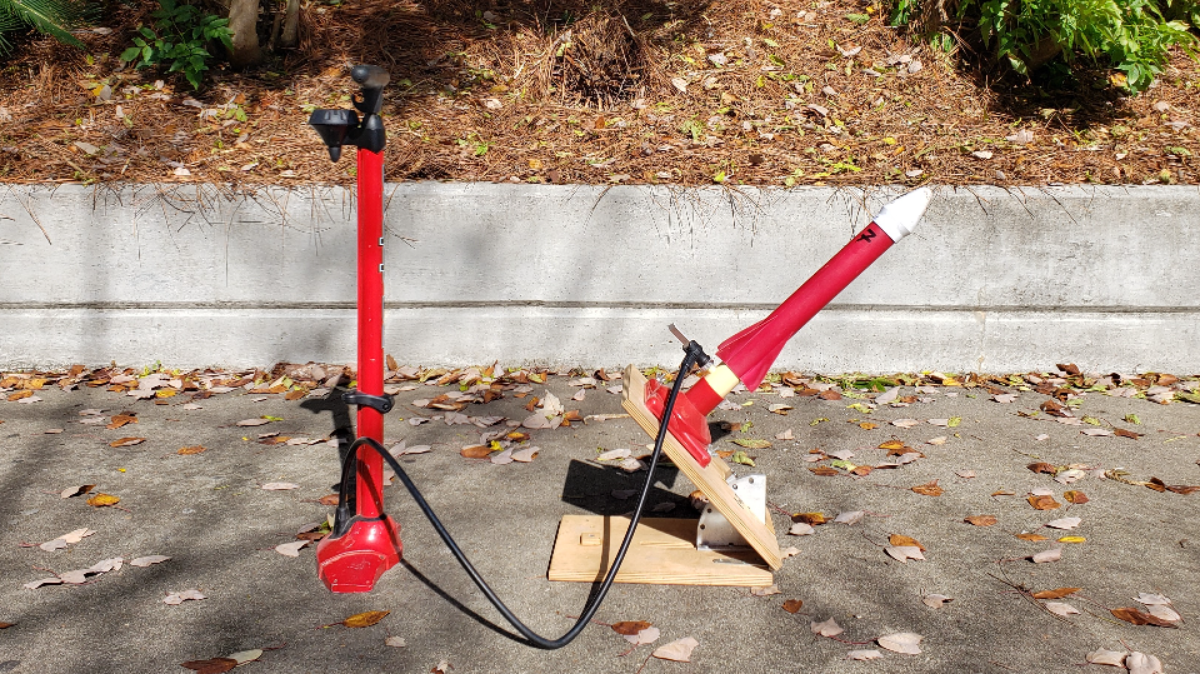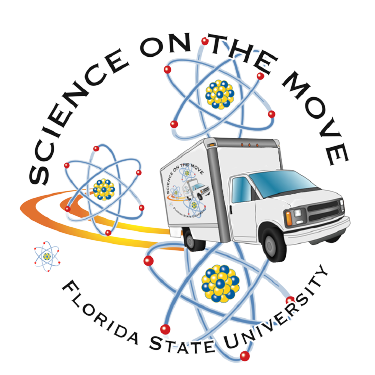Overview
Students use a bicycle-pump powered rocket to investigate the impact of launch angle and launch velocity on the horizontal range of the rocket. Students make predictions, observations and conclusions and consider elements of experimental design.
- Grades 4-12
- In person only
- The use of a large open field with an access point for the Science on the Move van is required.
Students use a bicycle-pump powered rocket to investigate the impact of launch angle and launch velocity on the horizontal range of the rocket. Students make predictions, observations and conclusions and consider elements of experimental design.
- Grades 4-12
- In person only
- The use of a large open field with an access point for the Science on the Move van is required.
Materials
- Rocket, including
- adjustable angle base
- adjustable caps to vary launch velocity
- Bicycle pump
- Trundle wheel
- Rocket, including
- adjustable angle base
- adjustable caps to vary launch velocity
- Bicycle pump
- Trundle wheel
Follow Up and Resources
This is a great launch point for further discussion of rockets, projectile motion, and kinematics. Check out the following:
- Projectile Motion simulation from PhET
- Rocket Educators Guide from NASA
This is a great launch point for further discussion of rockets, projectile motion, and kinematics. Check out the following:
- Projectile Motion simulation from PhET
- Rocket Educators Guide from NASA
Standards
Force and Changes in Motion
- SC.5.P.13.1: Identify familiar forces that cause objects to move, such as pushes or pulls, including gravity acting on falling objects.
- SC.5.P.13.2: Investigate and describe that the greater the force applied to it, the greater the change in motion of a given object.
Motion
- SC.912.P.12.2: Analyze the motion of an object in terms of its position, velocity, and acceleration (with respect to a frame of reference) as functions of time.
The Practice of Science
- SC.4.N.1.1: Raise questions about the natural world, use appropriate reference materials that support understanding to obtain information (identifying the source), conduct both individual and team investigations through free exploration and systematic investigations, and generate appropriate explanations based on those explorations.
- SC.4.N.1.4: Attempt reasonable answers to scientific questions and cite evidence in support.
- SC.5.N.1.1: Define a problem, use appropriate reference materials to support scientific understanding, plan and carry out scientific investigations of various types such as: systematic observations, experiments requiring the identification of variables, collecting and organizing data, interpreting data in charts, tables, and graphics, analyze information, make predictions, and defend conclusions.
- SC.6.N.1.1/SC.7.N.1.1/SC.8.N.1.1: Define a problem from the sixth/seventh/eighth grade curriculum, use appropriate reference materials to support scientific understanding, plan and carry out scientific investigation of various types, such as systematic observations or experiments, identify variables, collect and organize data, interpret data in charts, tables, and graphics, analyze information, make predictions, and defend conclusions.
- SC.7.N.1.4: Identify test variables (independent variables) and outcome variables (dependent variables) in an experiment.
Force and Changes in Motion
- SC.5.P.13.1: Identify familiar forces that cause objects to move, such as pushes or pulls, including gravity acting on falling objects.
- SC.5.P.13.2: Investigate and describe that the greater the force applied to it, the greater the change in motion of a given object.
Motion
- SC.912.P.12.2: Analyze the motion of an object in terms of its position, velocity, and acceleration (with respect to a frame of reference) as functions of time.
The Practice of Science
- SC.4.N.1.1: Raise questions about the natural world, use appropriate reference materials that support understanding to obtain information (identifying the source), conduct both individual and team investigations through free exploration and systematic investigations, and generate appropriate explanations based on those explorations.
- SC.4.N.1.4: Attempt reasonable answers to scientific questions and cite evidence in support.
- SC.5.N.1.1: Define a problem, use appropriate reference materials to support scientific understanding, plan and carry out scientific investigations of various types such as: systematic observations, experiments requiring the identification of variables, collecting and organizing data, interpreting data in charts, tables, and graphics, analyze information, make predictions, and defend conclusions.
- SC.6.N.1.1/SC.7.N.1.1/SC.8.N.1.1: Define a problem from the sixth/seventh/eighth grade curriculum, use appropriate reference materials to support scientific understanding, plan and carry out scientific investigation of various types, such as systematic observations or experiments, identify variables, collect and organize data, interpret data in charts, tables, and graphics, analyze information, make predictions, and defend conclusions.
- SC.7.N.1.4: Identify test variables (independent variables) and outcome variables (dependent variables) in an experiment.




